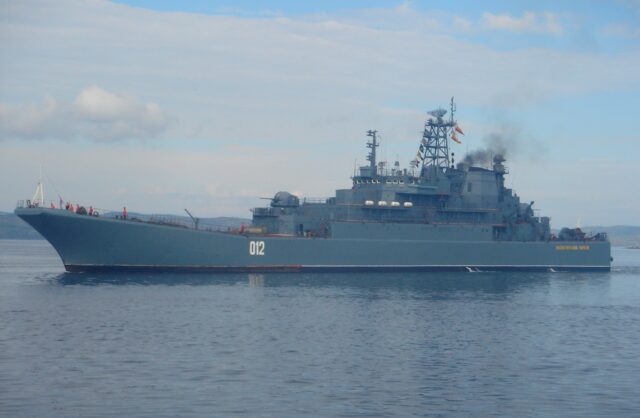
Ukraine Uses Innovative Drone and Missile Tactics to Combat Russian Dominance in Black Sea
Publication: Eurasia Daily Monitor Volume: 20 Issue: 177
By:

Over the past few months, the Ukrainian Armed Forces have relentlessly suppressed Russia’s military presence in the Black Sea and Crimea. On November 9, Ukrainian National Security and Defense Council Secretary Oleksii Danilov announced that Ukraine was making “huge gains” and “having great success in the Crimea direction” (Ukrinform, November 9). Without access to substantial surface warships, Ukrainian forces have carried out a series of high-precision missions using air and naval drones as well as cruise missiles to penetrate Russian defenses and strike multiple targets at sea (Ukrinform, August 4, October 5; Kyiv Independent, October 19, 30, November 10). Although Ukrainian kamikaze drones cause limited damage to most warships, Russian naval forces are gradually losing their combat potential to block Ukrainian grain shipments leaving Odesa and to conduct missile strikes against targets within Ukraine.
Since this past summer, a series of Ukrainian attacks on Russian forces in the Black Sea has pressured Moscow to reconsider its strategy at sea.
- On July 13, the Kerch Bridge was attacked. The Security Service of Ukraine reported that a new type of kamikaze naval drone was employed during the operation. The two drones used carried around 1 ton of explosives each. As a result, two sections of the bridge were damaged, and its use was restricted for three months (com, July 18).
- On August 4, a Project 775 Olenegorsk Hornyak landing ship was attacked during a raid on Novorossiysk, 5 kilometers (about 3 miles) from the port’s central infrastructure. The attack was carried out by the same type of kamikaze naval drone used in the attack on the Kerch Bridge. No personnel nor advanced weaponry were visible on the ship, which implies that the Russians felt they were not at risk of an attack at Novorossiysk. The attack itself was catastrophic. With another Russian naval base on the Black Sea compromised, Russian military officials were forces relocate some vessels. The landing ship suffered a large roll to the port side and had to be towed to the port for repair. Full repairs will likely be delayed due to a lack of spare parts on the Russian side (ua, August 4).
- On September 13, the Ukrainian Air Force attacked the dry dock of the Sevastopol shipyard with Storm Shadow missiles. The attack resulted in heavy damage to the Project 775 Minsk amphibious ship and the Project 636.3 Rostov-on-Don Russian mass media reported that 10 cruise missiles were used in the airstrike. It is unlikely that both ships will be fully repaired in the near future (Unian.net, September 13).
- On September 22, Ukrainian Special Operations Forces and the Ukrainian Air Force attacked modified Russian Su-24 fighter jets and the headquarters of the Russian Black Sea Fleet in Sevastopol with Storm Shadow missiles. Operation “Crab Trap” took place during a meeting of the Black Sea Fleet’s senior leadership. The headquarters was significantly damaged and images of the building on fire spread all over Russian and Ukrainian social media. The attacks on the Sevastopol shipyard and headquarters were preceded by attacks on Russia’s S-400 air defense systems in Crimea. These operations cleared a “corridor” for being able to reach more Russian military targets with drones and missile strikes (com, September 25). Shortly before the attack on the Russian fleet’s headquarters, its command post near Verkhnesadove, located 30 kilometers (over 18 miles) outside of Sevastopol, was hit by Ukrainian missiles (Fakty.com.ua, September 20).
- On November 5, Ukrainian forces seriously damaged the Project 22800 Askold missile corvette with French-supplied SCALP cruise missiles. The ship was moored at the Kerch Shipyard’s Zaliv pier and was being prepared for transfer to the Black Sea Fleet in December. Knocking this vessel offline was a major success, as it can carry eight Kalibr missiles at once and was equipped with the Pantsir-M anti-aircraft system (Unian, November 5).
- On November 10, Ukrainian naval drones attacked and sunk two Project 11770 Russian landing crafts with armored vehicles and military personnel on board at the Chornomorske Port in western Crimea. These vessels had the capability to deliver armored vehicles and personnel up to 600 nautical miles away at a speed of 30 knots. They had played a key role in supplying those Russian forces stationed in the occupied regions of Ukraine. The Black Sea Fleet no longer has any of these modernized landing craft, and construction of new vessels will not happen anytime soon (net, November 10)
A common strategy appears to undergird all these Ukrainian attacks. Swarms of drones and missiles penetrated Russian defenses and hit numerous targets, including warships, ammunition depots, air defense systems, radars, and even the Black Sea Fleet Headquarters. The successful use of naval drones against Russian military targets has compensated at least somewhat for the lack of strategic combat vessels in the Ukrainian Navy. As a result, Russia has withdrawn its newest ships, including two frigates, four corvettes, and two submarines carrying Kalibr missiles, to Novorossiysk. The Russian Navy was also forced to allocate scarce resources to strengthen the protection of all its Black Sea bases (Сensor.net, November 5).
Ukraine will likely continue to engage Russian forces in the Black Sea and Crimea with an effective combination of drone and missile attacks. In the view of this author, Ukraine still needs to develop surface fleet capabilities to completely break Russian maritime dominance and re-take control of its sovereign waters. A fleet of nimble, low-profile, maneuverable, and well-armed long boats with aerial and naval drones comprising a “mosquito fleet” could quickly and efficiently strengthen the Ukrainian Navy and improve its execution of offensive operations within confined and contested areas (see EDM, June 13).



